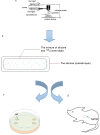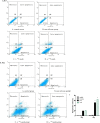Novel Silicone-Coated 125I Seeds for the Treatment of Extrahepatic Cholangiocarcinoma
- PMID: 26840346
- PMCID: PMC4740417
- DOI: 10.1371/journal.pone.0147701
Novel Silicone-Coated 125I Seeds for the Treatment of Extrahepatic Cholangiocarcinoma
Abstract
125I seeds coated with titanium are considered a safe and effective interstitial brachytherapy for tumors, while the cost of 125I seeds is a major problem for the patients implanting lots of seeds. The aim of this paper was to develop a novel silicone coating for 125I seeds with a lower cost. In order to show the radionuclide utilization ratio, the silicone was coated onto the seeds using the electro-spinning method and the radioactivity was evaluated, then the anti-tumor efficacy of silicone 125I seeds was compared with titanium 125I seeds. The seeds were divided into four groups: A (control), B (pure silicone), C (silicone 125I), D (titanium 125I) at 2 Gy or 4 Gy. Their anti-tumour activity and mechanism were assessed in vitro and in vivo using a human extrahepatic cholangiocarcinoma cell line FRH-0201 and tumor-bearing BALB/c nude mice. The silicone 125I seeds showed higher radioactivity; the rate of cell apoptosis in vitro and the histopathology in vivo demonstrated that the silicone 125I seeds shared similar anti-tumor efficacy with the titanium 125I seeds for the treatment of extrahepatic cholangiocarcinoma, while they have a much lower cost.
Conflict of interest statement
Figures









Similar articles
-
External radiotherapy and brachytherapy in the management of extrahepatic and intrahepatic cholangiocarcinoma: available evidence.Br J Radiol. 2017 Aug;90(1076):20170061. doi: 10.1259/bjr.20170061. Epub 2017 May 23. Br J Radiol. 2017. PMID: 28466653 Free PMC article. Review.
-
Mechanistic insights into 125I seed implantation therapy for Cholangiocarcinoma: focus on ROS-Mediated apoptosis and the role of GPX2.J Cancer Res Clin Oncol. 2024 Jun 25;150(6):324. doi: 10.1007/s00432-024-05840-0. J Cancer Res Clin Oncol. 2024. PMID: 38914724 Free PMC article.
-
Placement of ¹²⁵I seed strands and stents for a type IV Klatskin tumor.World J Gastroenterol. 2015 Jan 7;21(1):373-6. doi: 10.3748/wjg.v21.i1.373. World J Gastroenterol. 2015. PMID: 25574114 Free PMC article.
-
Induction of biliary cholangiocarcinoma cell apoptosis by 103Pd cholangial radioactive stent gamma-rays.Chin Med J (Engl). 2008 Jun 5;121(11):1020-4. Chin Med J (Engl). 2008. PMID: 18706251
-
Effect of 103Pd radioactive stent on caspase-9, cholangiocarcinoma cell growth and its radiosensitivity.Surg Oncol. 2011 Dec;20(4):247-51. doi: 10.1016/j.suronc.2010.02.001. Epub 2010 Mar 15. Surg Oncol. 2011. PMID: 20231087 Review.
Cited by
-
External radiotherapy and brachytherapy in the management of extrahepatic and intrahepatic cholangiocarcinoma: available evidence.Br J Radiol. 2017 Aug;90(1076):20170061. doi: 10.1259/bjr.20170061. Epub 2017 May 23. Br J Radiol. 2017. PMID: 28466653 Free PMC article. Review.
-
Biomedical Radioactive Glasses for Brachytherapy.Materials (Basel). 2021 Feb 27;14(5):1131. doi: 10.3390/ma14051131. Materials (Basel). 2021. PMID: 33673726 Free PMC article. Review.
-
The efficacy and safety of 125I seeds combined with biliary stent placement versus stent placement alone for malignant biliary obstruction: a systematic review and meta-analysis.Quant Imaging Med Surg. 2023 Jul 1;13(7):4589-4602. doi: 10.21037/qims-22-824. Epub 2023 May 10. Quant Imaging Med Surg. 2023. PMID: 37456287 Free PMC article.
References
-
- Khan SA, Taylor-Robinson SD, Toledano MB, Beck A, Elliott P, Thomas HC. Changing international trends in mortality rates for liver, biliary and pancreatic tumours.J Hepatol 2002;37:806–13. - PubMed
-
- Davilla JA, El-Serag HB. Cholangiocarcinoma: the ‘‘other”liver cancer on the rise. Am J Gastroenterol 2002;97:3199–200. - PubMed
-
- Park SW, Park YS, Chung JB. Patterns and relevant factors of tumor recurrence for extrahepatic bile duct carcinoma after radical resection. Hepatogastroenterology 2004;51:1612–8. - PubMed
Publication types
MeSH terms
Substances
LinkOut - more resources
Full Text Sources
Other Literature Sources
Medical

